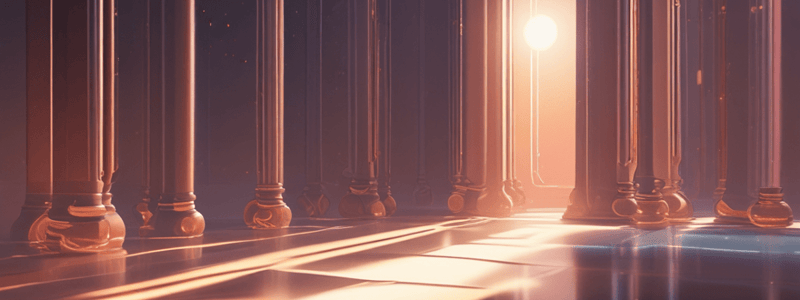Podcast
Questions and Answers
What creates an area of lower light intensity known as a shadow?
What creates an area of lower light intensity known as a shadow?
- Reflection of light off surfaces
- Angle of incidence of the light
- Opaque object obstructing sunlight (correct)
- Direct sunlight
Which factor does NOT influence the size and shape of a shadow?
Which factor does NOT influence the size and shape of a shadow?
- Distance between light source and object
- Angle at which light hits the object
- Color temperature of the light source (correct)
- Size of the object casting the shadow
What type of light source uses heat generated by an electrically charged filament to emit light?
What type of light source uses heat generated by an electrically charged filament to emit light?
- LED Lights
- Sunlight
- Incandescent Bulbs (correct)
- Fluorescent Lights
Which light source technology is known for being energy-efficient, long-lasting, and capable of producing light in various colors?
Which light source technology is known for being energy-efficient, long-lasting, and capable of producing light in various colors?
What fundamental property of light plays a significant role in the formation of shadows?
What fundamental property of light plays a significant role in the formation of shadows?
In shadow formation, what determines the angle at which light reflects off a surface?
In shadow formation, what determines the angle at which light reflects off a surface?
Which factor is NOT crucial in understanding how shadows are cast?
Which factor is NOT crucial in understanding how shadows are cast?
'Understanding the properties of light sources helps in designing experiments' - This statement emphasizes the importance of:
'Understanding the properties of light sources helps in designing experiments' - This statement emphasizes the importance of:
'...play a crucial role in the formation of shadows' - What plays a crucial role according to this statement?
'...play a crucial role in the formation of shadows' - What plays a crucial role according to this statement?
What is essential for designing lighting systems for different applications?
What is essential for designing lighting systems for different applications?
Which of the following is NOT a property of light?
Which of the following is NOT a property of light?
How does the property of refraction affect the appearance of objects in water?
How does the property of refraction affect the appearance of objects in water?
What is the primary cause of shadows forming?
What is the primary cause of shadows forming?
How does the property of absorption affect the appearance of an object's color?
How does the property of absorption affect the appearance of an object's color?
How does the property of reflection help in photography?
How does the property of reflection help in photography?
Which of the following properties of light is responsible for the formation of rainbows?
Which of the following properties of light is responsible for the formation of rainbows?
Which of the following properties of light is most responsible for the appearance of shadows?
Which of the following properties of light is most responsible for the appearance of shadows?
How does the property of scattering affect the appearance of an object's color?
How does the property of scattering affect the appearance of an object's color?
Which of the following properties of light is responsible for the separation of white light into its constituent colors when it passes through a prism?
Which of the following properties of light is responsible for the separation of white light into its constituent colors when it passes through a prism?
How does the property of polarization affect the appearance of light?
How does the property of polarization affect the appearance of light?
Study Notes
Properties of Light
Understanding the behavior of light is essential when studying shadows. Light exhibits several unique properties, including reflection, refraction, diffraction, interference, polarization, scattering, and dispersion. These characteristics allow us to observe various phenomena related to lights and shadows.
Reflection
Reflection is the phenomenon where light bounces off a surface and changes direction. When light reflects, it creates an image, such as a mirror's reflection of our surroundings. In photography, this property helps capture images by projecting light onto sensitive surfaces like photographic film or digital sensors.
Refraction
Refraction refers to how light changes speed and direction when passing through different media, such as water, glass, or air. This leads to changes in wavelength and frequency, which can result in phenomena like raindrops acting as prisms, separating sunlight into its colors.
Absorption
When light encounters a material, some may get absorbed while others are transmitted or reflected. Some materials absorb all incident light, while others only absorb specific wavelengths. This selective absorption can lead to particular colors being more apparent when placed against different backgrounds.
Light's properties play a crucial role in the formation of shadows, which we will discuss next.
Formation of Shadows
Shadows arise due to the blocking or deflection of light waves. A shadow is essentially an area of lower light intensity resulting from an opaque object obstructing direct sunlight. When sunlight strikes an object, it illuminates one side and casts a shadow on the opposite side.
The size and shape of a shadow depend on various factors, such as the distance between the source of light and the object casting the shadow, the size of the object, and the angle at which the light hits the object.
Now let's move on to discussing different types of light sources commonly used to study shadows.
Types of Light Sources
Various artificial and natural light sources are employed in the field of lighting technology and physics research. Here are some common examples:
Sunlight
Sunlight serves as a primary natural light source responsible for creating shadows during daytime hours. It can produce high contrast shadows with varying textures depending on weather conditions and time of day.
Incandescent Bulbs
Incandescent bulbs emit light using heat generated by an electrically charged filament inside the bulb. They offer warm light with low color temperatures.
Fluorescent Lights
Fluorescent lamps generate light through a gas-discharge process involving ionized mercury vapor. They consume less energy compared to incandescent bulbs but may have a different color temperature and quality of light.
LED Lights
Light Emitting Diodes (LEDs) are a newer light source technology that uses semiconductors to emit light when an electric current is applied. LEDs are energy-efficient, long-lasting, and can produce light in various colors.
Understanding the properties of light sources helps in designing experiments and understanding how they interact with various materials and surfaces to create different types of shadows.
Reflection of Light
Reflection is a fundamental property of light that plays a significant role in the formation of shadows. When light reflects off a surface, it bounces back in a different direction. This interaction can create various effects, such as glare or highlights, which can be observed in the shadows formed.
The angle at which light reflects off a surface is determined by the angle of incidence. This property is crucial in understanding how shadows are cast and can help in designing lighting systems for various applications.
In conclusion, the properties of light, light sources, and their interactions with surfaces play a crucial role in the formation of shadows. Understanding these principles can lead to innovative applications in fields like photography, filmmaking, and architectural design.
In the next section, we will delve deeper into the role of light absorption in the formation of shadows and their characteristics.
Studying That Suits You
Use AI to generate personalized quizzes and flashcards to suit your learning preferences.
Description
Test your knowledge on the properties of light, including reflection, refraction, and absorption, as well as the formation of shadows. Explore the behavior of different types of light sources and their impact on shadow creation. Gain insights into the interactions between light and surfaces.




